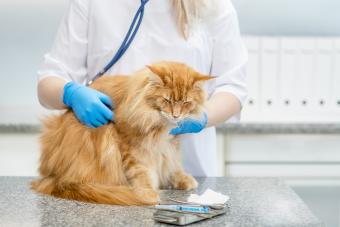
If your cat's coat is looking dull and they are losing hair in circular patches, it's a good idea to learn about the symptoms of ringworm in cats. This condition is not an actual worm, but instead, a fungus that can spread to other animals and humans in your house. Understanding how to spot this infection and effectively treat it can help improve your cat's quality of life, their appearance, and prevent transmission to others.
Signs of Ringworm in Cats
Skin conditions in cats can present very similarly, which is why it's important to learn how to differentiate ringworm from other diseases. Cats suffering from the ringworm fungus are plagued with sporadic lesions of circular hair loss, and these lesions tend to look slightly irritated and scaly. Sometimes the center of the "ring" contains a pustule, and the animal may appear greasy, as well.

Along with these telltale rings, accompanying signs of ringworm infection may include the following.
- Brittle/broken hair
- Extreme dandruff
- Balding
- Crusty nail beds
- Excessive shedding, often leading to an increase in hairballs
- Pruritis/self-mutilation
- Chin acne
- Mouth ulcers
Most ringworm lesions are initially found around a cat's head, ears, and tail regions, but a prolonged infection can spread and result in lesions all over the animal's body. It's also possible for the fungus to make its way down into a cat's ear canals, leading to chronic ear infections.
What Is Ringworm?
Just the very word "ringworm" can throw some people into a panic, but most don't actually understand what this organism is. Although some people believe it's a worm, similar to the other worms that pets and people can be susceptible to, ringworm is actually the common name for a group of fungal species.

Of this group, Microsporum canis is the most common cause of a ringworm infection in pets and people. Yes -- the infection is equally transferable between dogs, cats, and humans. So, the next question is, how do we contract a ringworm infection?
Ringworm Transmission
Ringworm in cats is most typically contracted through cat-to-cat contact, but it can also be picked up from shared grooming equipment and living quarters. Ringworm spores can be shed anywhere in the environment so they're easy to pick up. This fungus seems to prefer hot, humid climates, but since it can last in the environment for up to 18 months, it's possible to contract ringworm nearly any time of year.
Fortunately, a strong immune system is usually enough to ward off a full blown infection in many cases. However, cats suffering from feline leukemia or feline immunodeficiency virus are at increased risk for the fungus due to their suppressed immune systems.
How to Diagnose Ringworm
Most cases of ringworm in cats can be diagnosed from the telltale lesions. However, the fungus can sometimes appear fluorescent when viewed under a black light. The most common methods of diagnosis include the following.
- Visual examination of lesions.
- Examination under ultraviolet light to assess if area fluoresces.
- A microscopic examination of hairs plucked from the edge of the ring, which can reveal the fungus imbedded in the shafts.
- A sample from one of the crusty lesions can be cultured to reveal fungal growth.
Misdiagnosing Ringworm on a Cat's Tail
One very common location for ringworm is a cat's tail. However, balding in this location can be confused with other ailments. Some cat owners may worry that hair loss on the tail is due to over grooming, allergies, anal gland issues, hormone imbalance, or trauma to the tail (such as getting it stuck in a door or recliner). But often, this is actually ringworm. Similarly, hair loss or scabbing around the temples can look like a number of different skin disorders. It's important to rule out ringworm in these cases.
Treatment Options
If you suspect that your cat has ringworm or you've received a diagnosis from your vet, there are a few different approaches to treatment.
Topical Ointment
In some cases, a less advanced ringworm infection can be treated by shaving the hair from the affected areas and applying an antifungal cream, such as Miconazole. Only use an ointment on your cat that has been prescribed by your vet. It's important to prevent cats from licking the ointment, so a cone may be necessary. In long-haired cat breeds, some vets recommend completely shaving the cat to eradicate the fungus in the hair shafts and reveal hidden lesions that can then be treated.

Special Baths or Dips
A common method used in shelters and vet hospitals is a lime sulfur dip. This solution halts the growth and spread of the ringworm, but can be caustic if it gets into a cat's eyes or mouth. There are strict guidelines for lime sulfur dips to ensure that they work effectively and to keep the cat safe. As the name implies, the solution smells terribly like sulfur and will dye any light-colored portions of your cat's fur bright yellow.
Oral Medication
Sometimes, oral antifungal medication such as Ketoconazole is also used to cure a ringworm infection, but this treatment is usually reserved for more severe infections because the drugs used carry a risk of toxicity.
Preventing Ringworm Infections
Avoiding a case of ringworm is certainly easier than treating one, and there are protective measures you can take to reduce the chances you and your pet will become infected.
- Keep your cat indoors and away from stray cats and dogs.
- Keep your environment, and especially your cat's bedding, very clean.
- Before bringing home an adopted cat or kitten, have your vet examine and possibly test the animal for ringworm.
- If purchasing a pet from a commercial cattery, try to visit a closed cattery that doesn't allow other pets into the building.
Be Vigilant To Catch Ringworm in Cats Early
Ringworm is not a death sentence, but it can become a chronic problem that severely dampens the quality of your cat's life. As you give your cat their weekly brushing, take a moment to look through their fur for the earliest sign of skin lesions. If you find anything that looks suspicious, get in touch with your vet right away.







